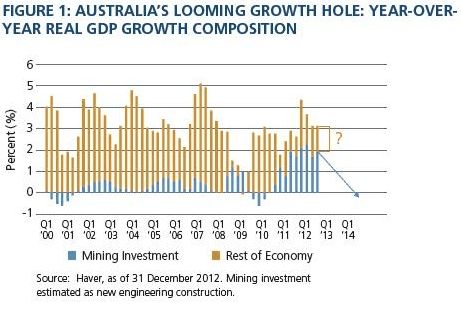
Crikey’s Bernard Keane and Glenn Dyer are out today with a Panglossian assessment of Australian housing construction. Let’s take a look:
This Friday the housing finance figures for May will be pored over by economists in Federal Treasury and especially the Reserve Bank for further evidence that new home industry is rebounding. Both institutions and their masters, along with some private-sector economists, know that a boom is taking shape in the new home market, thanks to record low interest rates — the question is its sustainability and whether it will be enough to help pick up the slack emerging in the economy from the slowdown in mining investment.
On current indications it probably will last and help cushion the wider economy from a big hit from the effects of mining investment returning to more sedate levels. In fact, such has been the acceleration in new home approvals and construction since late last year that in more normal times the Reserve Bank’s next move in interest rates would be an increase as it sought to control the pressures being built up in the volatile housing sector.
Consider the evidence. According to the Housing Industry Association, new home sales in April hit an 18-month high. In the April housing finance stats, finance for the construction of new homes hit the highest level in three years (since April 2010), while finance to purchase a newly built home hit the highest level since the middle of 2007, as there GFC started to erupt overseas (all seasonally adjusted) .
All well and good until you examine the time series, where the data shows only a tepid recovery in new home sales from record lows:
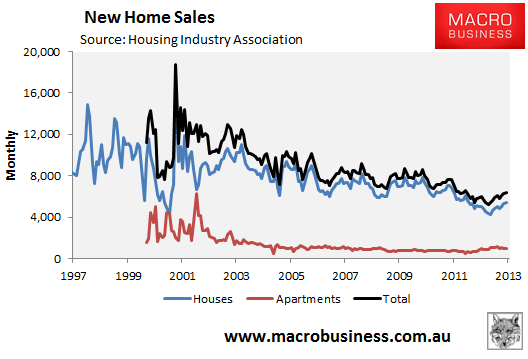
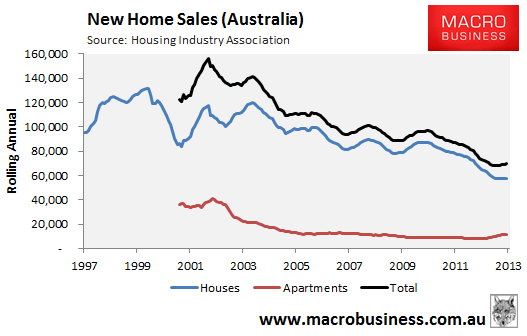
The improvement in new housing finance commitments has been better, but hardly “boom” conditions:
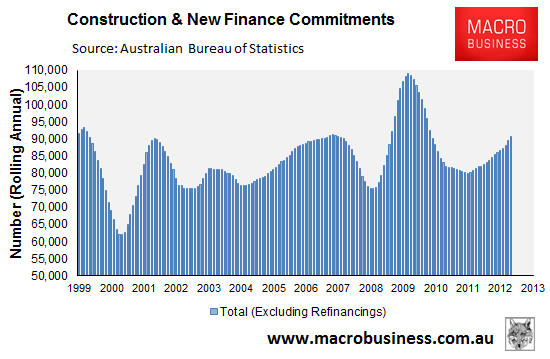
Back to Crikey:
And last Thursday’s building approvals for May seasonally adjusted new private house building approvals rose 2.5% in May, to be 11.6% higher over the year (10% in trend terms). That’s the strongest rate for more than two years, and the number of approvals — 8113 (seasonally adjusted) — was the highest since March 2011.
Private house approvals have now risen in each of the past five months, and with some states continuing their grants for first-home building, (NSW’s changed on July 1 from first-home buyers to first-home builders only), it’s clear that the the long-awaited rebound in this industry is now underway, although it is happening slowly.
The extent of the boom can be seen by comparing the year to May rise of 11.6% rise (seasonally adjusted) with the 3.8% fall in the year to December (i.e. for all of 2012).
Many media reports concentrate on overall approvals, but they continue to be volatile, influenced by the bunching of local government approvals each month (or delays) for units, apartments and townhouses. For example, overall dwelling approvals (which include units and apartments, townhouses, etc) fell 1.1% in May after a 9.5% rise in April. That was because of a 9.8% fall in non-house private dwelling approvals in May, against the 18% rise in April…
Again, dwelling approvals are improving, but they could hardly be described as “boom” conditions. Overall approvals are merely tracking in line with the 30-year average (despite Australia’s population growing by around 45% over that period), whereas detached house approvals remain in the gutter (see next chart).
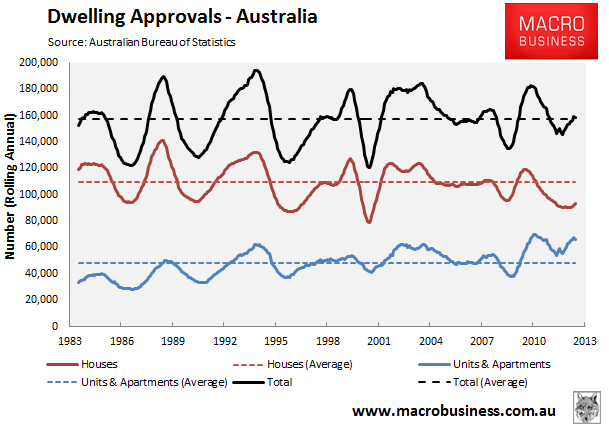
Back to Crikey:
In his speech in Brisbane last Wednesday, Reserve Bank governor Glenn Stevens pointed out the extent of the gathering surge in housing activity.
“Dwelling investment has been low for an unusually long period, with at least some households intent on reducing debt, thereby strengthening balance sheets. Households have accumulated a good deal of cash as well over recent years. Meanwhile, population growth is quite solid and it has been picking up a bit of late. If anything, we will need to build more dwellings than we have been over recent years. Meanwhile, interest rates are low, dwellings are more ‘affordable’, and finance approvals for housing purchases have risen by 16 per cent over the past year.”
The purchase of existing homes hardly adds to economic growth. But the financing and construction of new homes (and units, townhouses, etc) adds real value and is a big growth driver. And it’s exactly the transition the RBA wanted to see follow the peak of the mining boom.
I doubt the RBA is too impressed at all by the construction uplift, which has been underwhelming, and a major question remains over whether its enough to offset the hit to growth and employment as the mining investment boom unwinds:
